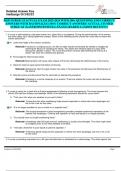Exam (elaborations)
MED SURGE GI ACTUAL EXAM WITH 100+ QUESTIONS AND CORRECT ANSWERS WITH RATIONALES (100% CORRECT ANSWERS) ACTUAL ATI MED SURGE GI (GASTROINTESTINAL) EXAM GRADED A+(MOST RECENT!!)
- Course
- Institution
MED SURGE GI ACTUAL EXAM WITH 100+ QUESTIONS AND CORRECT ANSWERS WITH RATIONALES (100% CORRECT ANSWERS) ACTUAL ATI MED SURGE GI (GASTROINTESTINAL) EXAM GRADED A+(MOST RECENT!!)
[Show more]



